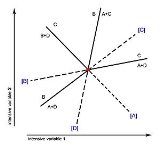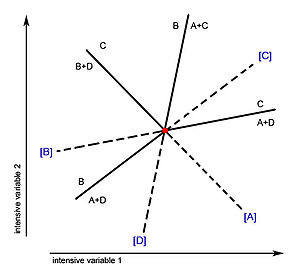
Schreinemaker's analysis
Encyclopedia
Schreinemaker's Analysis is the use of Schreinemaker's Rules to create a phase diagram
.
After applying Schreinemaker's Rules and creating a phase diagram, the resulting geometric figure will be thermodynamically
accurate, although the axes
will be undetermined. In order to determine the correct orientation of the geometric figure obtained through Schreinemaker's Rules, one must have additional information about the given reactions
or go through an analytical treatment of the thermodynamics of the relevant phases
.
lines. The extension of a univariant line through the invariant point is called the metastable extension. Univariant lines are usually drawn as a solid line while their metastable extensions are drawn as a dotted line.
Univariant lines and their metastable extensions are often labeled by putting in square brackets the phase that is absent from the reaction associated with the given univariant line. In other words, since every univariant line represents a chemical equilibrium
, these equilibrium curves are named with the phase (or phases) that is not involved in the equilibrium.
Take an example with four phases: A, B, C, D. If a univariant line is defined by the equilibrium reaction A+D←→C, this univariant line would be labeled [B], because the phase B is absent from the reaction A+D←→C.
A univariant line thus represents a univariant system with 1 degree of freedom. Two univariant lines can then define a divariant area with 2 degrees of freedom.
where both axes
are intensive thermodynamic variables.
There are many correct collections of "Schreinemaker's Rules" and the choice to use a given set of rules depends on the nature of the phase diagrams being created. Due to the phrasing of the Morey-Schreinemaker Coincidence Theorem, only one rule is essential to the Schreinemaker's Rules. This is the so-called metastable extensions rule:
 This rule is geometrically sound in the construction of phase diagrams since for every metastable reaction, there must be a phase that is relatively stable. This phase must be the one which does not participate in the reaction and is therefore not consumed as a reactant or formed as a product, thus being "stable."
This rule is geometrically sound in the construction of phase diagrams since for every metastable reaction, there must be a phase that is relatively stable. This phase must be the one which does not participate in the reaction and is therefore not consumed as a reactant or formed as a product, thus being "stable."
Some collections of Schreinemaker's Rules will contain the following, additional, basic statements:
In the example above with the equilibrium reaction A+D←→C, (A+D) is an assemblage as well as (C) on its own.
Phase diagram
A phase diagram in physical chemistry, engineering, mineralogy, and materials science is a type of chart used to show conditions at which thermodynamically distinct phases can occur at equilibrium...
.
After applying Schreinemaker's Rules and creating a phase diagram, the resulting geometric figure will be thermodynamically
Thermodynamics
Thermodynamics is a physical science that studies the effects on material bodies, and on radiation in regions of space, of transfer of heat and of work done on or by the bodies or radiation...
accurate, although the axes
Axes
Axes may refer to:* Axes, woodworking hand tools* The plural of axis* Axes , a 2005 rock album by the British band Electrelane* X and Y axes, or X, Y, and Z axes, perpendicular lines used in the Cartesian coordinate system...
will be undetermined. In order to determine the correct orientation of the geometric figure obtained through Schreinemaker's Rules, one must have additional information about the given reactions
Chemical reaction
A chemical reaction is a process that leads to the transformation of one set of chemical substances to another. Chemical reactions can be either spontaneous, requiring no input of energy, or non-spontaneous, typically following the input of some type of energy, such as heat, light or electricity...
or go through an analytical treatment of the thermodynamics of the relevant phases
Phase (matter)
In the physical sciences, a phase is a region of space , throughout which all physical properties of a material are essentially uniform. Examples of physical properties include density, index of refraction, and chemical composition...
.
Metastable Extensions
Univariant lines are sometimes called reactionChemical reaction
A chemical reaction is a process that leads to the transformation of one set of chemical substances to another. Chemical reactions can be either spontaneous, requiring no input of energy, or non-spontaneous, typically following the input of some type of energy, such as heat, light or electricity...
lines. The extension of a univariant line through the invariant point is called the metastable extension. Univariant lines are usually drawn as a solid line while their metastable extensions are drawn as a dotted line.
Univariant lines and their metastable extensions are often labeled by putting in square brackets the phase that is absent from the reaction associated with the given univariant line. In other words, since every univariant line represents a chemical equilibrium
Chemical equilibrium
In a chemical reaction, chemical equilibrium is the state in which the concentrations of the reactants and products have not yet changed with time. It occurs only in reversible reactions, and not in irreversible reactions. Usually, this state results when the forward reaction proceeds at the same...
, these equilibrium curves are named with the phase (or phases) that is not involved in the equilibrium.
Take an example with four phases: A, B, C, D. If a univariant line is defined by the equilibrium reaction A+D←→C, this univariant line would be labeled [B], because the phase B is absent from the reaction A+D←→C.
Morey-Schreinemaker Coincidence Theorem
The Morey-Schreinemaker Coincidence Theorem states that for every univariant line that passes through the invariant point, one side is stable and the other is metastable. The invariant point marks the boundary of the stable and metastable segments of a reaction line.Phase Rule
An invariant point is defined as a representation of an invariant system (0 degrees of freedom by Gibbs' phase rule) by a point on a phase diagram.A univariant line thus represents a univariant system with 1 degree of freedom. Two univariant lines can then define a divariant area with 2 degrees of freedom.
Metastable Extensions Rule
From the Morey-Schreinemaker Coincidence Theorem, Schreinemaker's Rules can be determined. These rules can be used in the creation of an accurate phase diagramPhase diagram
A phase diagram in physical chemistry, engineering, mineralogy, and materials science is a type of chart used to show conditions at which thermodynamically distinct phases can occur at equilibrium...
where both axes
Axes
Axes may refer to:* Axes, woodworking hand tools* The plural of axis* Axes , a 2005 rock album by the British band Electrelane* X and Y axes, or X, Y, and Z axes, perpendicular lines used in the Cartesian coordinate system...
are intensive thermodynamic variables.
There are many correct collections of "Schreinemaker's Rules" and the choice to use a given set of rules depends on the nature of the phase diagrams being created. Due to the phrasing of the Morey-Schreinemaker Coincidence Theorem, only one rule is essential to the Schreinemaker's Rules. This is the so-called metastable extensions rule:
The metastable extension of the [phase-absent] reaction must fall in the sector in which that phase is stable in all possible assemblages.

Some collections of Schreinemaker's Rules will contain the following, additional, basic statements:
- No assemblage has a stability area greater than 180°.
- All reactants and products are stable in the field where the reaction plots.
- The absent phase is unstable where the reaction plots.
- Complex reactions (high number of participating phases) usually lie within bounding, simple reactions defining the phase stability region.
- The simplest divariant region usually contains the most metastable extensions.
- If each stable and metastable reaction curve is labeled with the absent phase, then the order of the named curves as you proceed around the invariant point should cycle through all phases twice in order of their relative reaction components.
Assemblages
An assemblage is defined as the phases on one side of an equilibrium reaction. An assemblage can be either a single phase or a collection of phases.In the example above with the equilibrium reaction A+D←→C, (A+D) is an assemblage as well as (C) on its own.

